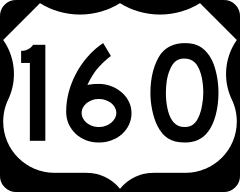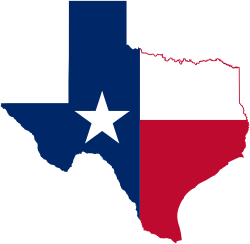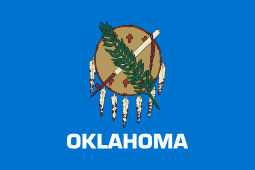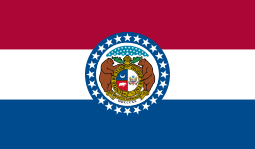Interstate 44
| |
|---|---|
 | |
| Route information | |
| Length: | 633.79 mi[1] (1,019.99 km) |
| Major junctions | |
| West end: |
|
|
| |
| East end: |
|
| Location | |
| States: | Texas, Oklahoma, Missouri |
| Highway system | |
Interstate 44 (I-44) is a major Interstate Highway in the central United States. Nominally an east-west road as it has an even number, it follows a more southwest-northeast alignment. Its western terminus is in Wichita Falls, Texas at a concurrency with U.S. Route 277 (US 277), US 281, and U.S. Route 287 in Texas; its eastern terminus is at I-70 in St. Louis, Missouri. I-44 is one of five interstates built to bypass U.S. Route 66; this highway covers the section between Oklahoma City and St. Louis.
Virtually the entire length of I-44 east of Springfield, Missouri was once US 66, which was upgraded from two to four lanes from 1949 to 1955. The section of I-44 west of Springfield was built farther south than US 66 in order to connect Missouri's section with the already completed Will Rogers Turnpike, which Oklahoma wished to carry their part of I-44.
Route description
| mi | km | |
|---|---|---|
| TX | 15 | 24 |
| OK | 329 | 530 |
| MO | 293 | 471 |
| Total | 637 | 1,025 |
Texas
In the U.S. state of Texas, I-44 has a short, but regionally important, 14.77 miles (23.77 km) stretch, connecting Wichita Falls with Oklahoma. The route runs almost due north to the Texas–Oklahoma state line at the Red River. In Wichita Falls, I-44 runs concurrent with US 277, US 281, and US 287, and is known locally as the "Central Freeway". I-44 provides access to downtown Wichita Falls and Sheppard Air Force Base.
Oklahoma

I-44 in Oklahoma is mostly three separate toll roads; it is paralleled by former US 66 from Oklahoma City to the Missouri line. In southwestern Oklahoma, I-44 is the H. E. Bailey Turnpike and is mainly south–north. In the Oklahoma City area, I-44 is either six or eight lanes; it runs concurrent with I-35 for about 4 miles (6.4 km) in Oklahoma City. From Oklahoma City, I-44 becomes southwest–northeast as the Turner Turnpike towards Tulsa. After I-44 leaves Tulsa, it becomes the Will Rogers Turnpike to the Missouri state line.
Missouri

I-44 enters Missouri southwest of Joplin near the tripoint of Oklahoma, Missouri, and Kansas. It misses the Kansas border by less than 200 yards (180 m). The first exit in Missouri is for US-166. I-44 continues through the southern part of Joplin, where it becomes concurrent with the new Missouri segment of I-49. East of Joplin, I-49 splits off on its own alignment to Kansas City.
I-44 then continues east on the former US-166 to Mount Vernon. At the northeast part of Mount Vernon, I-44 heads northeast, while old US-166 continued east on Missouri Route 174. The section of road to Halltown is a completely new road, not bypassing any previous highways. At Halltown, the road follows the general pathway of US-66 all the way to downtown St. Louis.

I-44 passes through Springfield on the north side of the city and continues northeast. At Waynesville, I-44 enters a very hilly and curvy area until it passes Rolla. Although the road still passes through some hilly areas, none are as steep as that particular stretch.
At Pacific, I-44 begins to widen to six lanes, later to eight lanes. The interstate proceeds through the suburbs of St. Louis and thence into downtown St. Louis passing the Gateway Arch before finally terminating near the Mississippi River, continuing from there as I-70 from the west end of the Stan Musial Veterans Memorial Bridge. Until a future second span of the new bridge is completed, there will be no way for I-44 traffic to utilize the new Stan Musial Veterans Memorial span without first exiting to surface streets. I-44 traffic wishing to continue northeast and east must use the Poplar Street Bridge and I-55/I-64 to cross the Mississippi River.
At some places, an "Alternate I-44" is posted. One such ran between Rolla and Springfield via US-60 and US-63 and another ran via US-63 and US-50 between Rolla and Union. These were completed to provide traffic relief during road work. The latter of these alternate routes detoured traffic around three-hour delays due to road work near Cuba.
History
I-44 was originally signed in 1958 as an Interstate designation of the Turner Turnpike linking Oklahoma City and Tulsa and the Will Rogers Turnpike linking Tulsa and the Missouri state line southwest of Joplin, along with the US-66 bypass in Tulsa that linked that city with the two turnpikes and the continued four-lane highway from the Missouri border to an interchange with US-71 south of Joplin previously designated as US-166.
As US 66 was being bypassed by I-44, the Route 66 Association requested the designation Interstate 66 for I-44 from St. Louis to Oklahoma City. AASHTO rejected the request.[2]
At the time the I-44 designation was assigned in Oklahoma in the 1950s, Oklahoma signed the mile markers west to east starting at Turner Turnpike's Oklahoma City terminus at the I-44/I-35 interchange (near Edmond). I-44 was extended in 1982 southwest of Oklahoma City along the existing H. E. Bailey Turnpike, thus raising the mile markers by about 100. The addition of the new section was unusual in that it is a more south–north segment, and didn't directly connect to the previous western end at I-35. It now extends south of I-40, thus traveling beyond the usual Interstate numbering conventions.
What was once I-244 around St. Louis is currently part of that city's I-270/I-255 beltway.
During the historic 1999 Oklahoma tornado outbreak, an F5 tornado crossed I-44. This particular tornado had the fastest tornado wind speeds on record. The interstate was severely damaged where the tornado crossed it. In the end, this tornado was blamed for 36 deaths.
A section of I-44 was moved slightly north between Powellville, Missouri and Doolittle. The old road is highly visible for eastbound traffic near Powellville. As of April 2006, the rocks carved away for the new roadbed have virtually no lichen, reflecting that this construction occurred rather recently.[3]
Junction list
- Texas
-


 US 277 / US 281 / US 287 in Wichita Falls. I-44/US 287 travels concurrently through Wichita Falls. I-44/US 277/US 281 travels concurrently to west-southwest of Randlett, Oklahoma.
US 277 / US 281 / US 287 in Wichita Falls. I-44/US 287 travels concurrently through Wichita Falls. I-44/US 277/US 281 travels concurrently to west-southwest of Randlett, Oklahoma. - Oklahoma
-


 US 70 / US 277 / US 281 west of Randlett
US 70 / US 277 / US 281 west of Randlett -

 US 277 / US 281 in Walters
US 277 / US 281 in Walters -

 US 277 / US 281 northwest of Geronimo. The highways travel concurrently to east of Medicine Park.
US 277 / US 281 northwest of Geronimo. The highways travel concurrently to east of Medicine Park. -
 US 62 in Lawton. The highways travel concurrently to east of Medicine Park.
US 62 in Lawton. The highways travel concurrently to east of Medicine Park. -
 US 277 in Elgin
US 277 in Elgin -

 US 81 / US 277 in Chickasha
US 81 / US 277 in Chickasha -

 US 62 / US 277 in Chickasha
US 62 / US 277 in Chickasha -
 US 62 in Newcastle. I-44/US 62 travels concurrently to Oklahoma City.
US 62 in Newcastle. I-44/US 62 travels concurrently to Oklahoma City. -

 I‑240 / US 62 in Oklahoma City
I‑240 / US 62 in Oklahoma City -

 I‑40 / US 270 in Oklahoma City
I‑40 / US 270 in Oklahoma City -

 I‑235 / US 77 in Oklahoma City
I‑235 / US 77 in Oklahoma City -
 I‑35 in Oklahoma City. The highways travel concurrently through northeast Oklahoma City.
I‑35 in Oklahoma City. The highways travel concurrently through northeast Oklahoma City. -
 US 377 in Stroud
US 377 in Stroud -
 I‑244 on the Sapulpa–Oakhurst line
I‑244 on the Sapulpa–Oakhurst line -
 US 75 in Tulsa
US 75 in Tulsa -
 US 64 in Tulsa
US 64 in Tulsa -
 US 169 in Tulsa
US 169 in Tulsa -

 I‑244 / US 412 in Tulsa. I-44/US 412 travels concurrently to the Tulsa–Fair Oaks line
I‑244 / US 412 in Tulsa. I-44/US 412 travels concurrently to the Tulsa–Fair Oaks line -
 US 69 in Big Cabin
US 69 in Big Cabin -

 US 60 / US 69 in Vinita
US 60 / US 69 in Vinita -


 US 59 / US 60 / US 69 northeast of Afton
US 59 / US 60 / US 69 northeast of Afton - Missouri
-

 US 166 / US 400 west-northwest of Loma Linda
US 166 / US 400 west-northwest of Loma Linda -

 I‑49 / US 71 south-southwest of Duenweg. The highways travel concurrently to Fidelity.
I‑49 / US 71 south-southwest of Duenweg. The highways travel concurrently to Fidelity. -
 US 160 in Springfield
US 160 in Springfield -
 US 65 in Springfield
US 65 in Springfield -
 US 63 in Rolla
US 63 in Rolla -
 US 50 south-southwest of Villa Ridge. The highways travel concurrently to the Sunset Hills–Kirkwood city line.
US 50 south-southwest of Villa Ridge. The highways travel concurrently to the Sunset Hills–Kirkwood city line. -
 I‑270 in Sunset Hills
I‑270 in Sunset Hills -


 US 50 / US 61 / US 67 on the Sunset Hills–Kirkwood city line
US 50 / US 61 / US 67 on the Sunset Hills–Kirkwood city line -
 I‑55 in St. Louis. The highways travel concurrently through St. Louis
I‑55 in St. Louis. The highways travel concurrently through St. Louis -


 I‑55 / I‑64 / US 40 in St. Louis
I‑55 / I‑64 / US 40 in St. Louis -
 I‑70 in St. Louis
I‑70 in St. Louis
Auxiliary routes
- Tulsa, Oklahoma - I-244, I-444 (unsigned)
- St. Louis, Missouri - I-244 decommissioned in 1974, today signed as I-270.
Business routes
All business loops of I-44 are located in Missouri. They serve Joplin, Sarcoxie, Mount Vernon, Springfield, Lebanon, Waynesville–St. Robert, Rolla, and Pacific. A business spur links I-44 with Fort Leonard Wood.
See also
-
 U.S. Roads portal
U.S. Roads portal -
 Texas portal
Texas portal -
 Oklahoma portal
Oklahoma portal -
 Missouri portal
Missouri portal
References
- ↑ "Route Log - Main Routes of the Eisenhower National System Of Interstate and Defense Highways - Table 1". Retrieved 4 October 2014.
- ↑ McNichol, Dan. The Roads that Built America: The Incredible Story of the U.S. Interstate System. New York: Sterling Publishing Co., Inc, 2006.
- ↑ "Aerial photo". Retrieved 4 October 2014.
External links
-
 Media related to Interstate 44 at Wikimedia Commons
Media related to Interstate 44 at Wikimedia Commons - Interstate 44 on Interstate-guide.com
